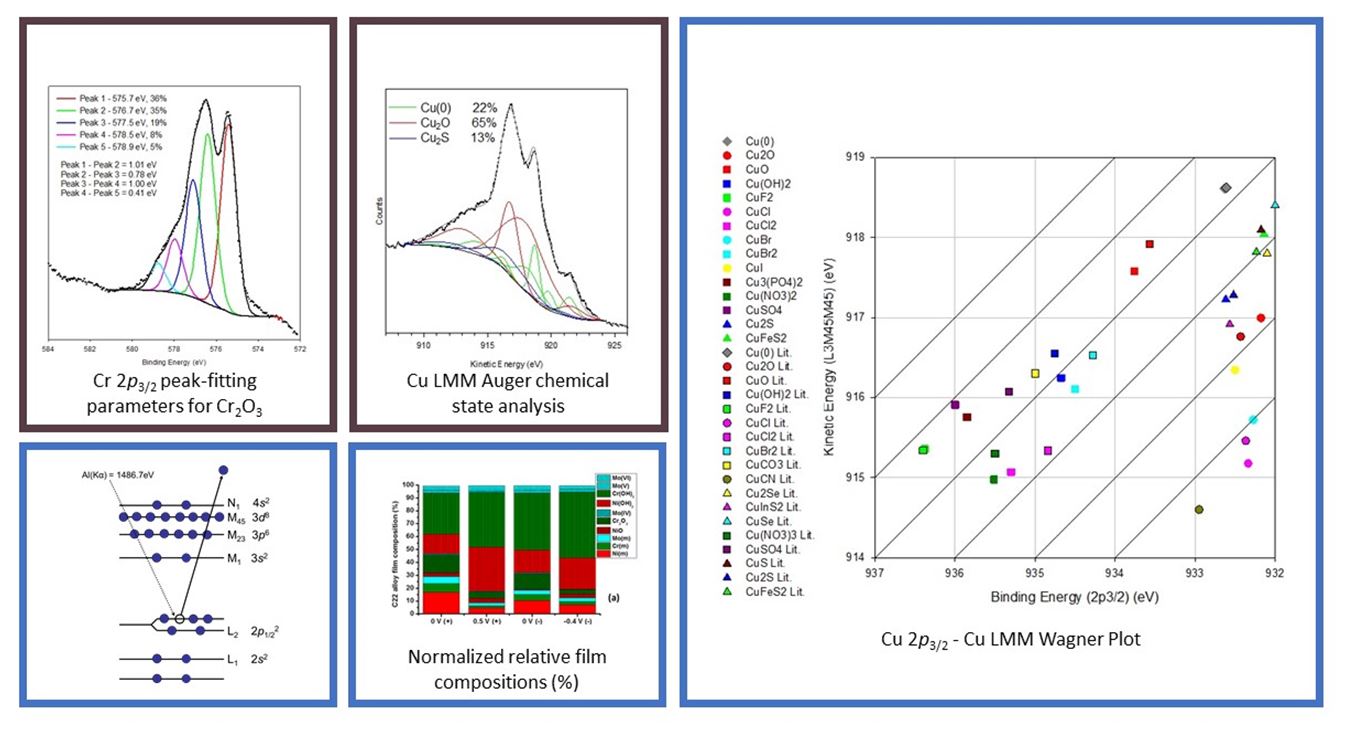Video Article Open Access
New Frontiers in Chemical State Analysis using X-ray Photoelectron Spectroscopy (XPS)
Mark C. Biesinger
Surface Science Western and Department of Chemistry, University of Western Ontario, London, N6G 0J3, Canada
Vid. Proc. Adv. Mater., Volume 2, Article ID 2021-0179 (2021)
DOI: 10.5185/vpoam.2021.0179
Publication Date (Web): 13 Feb 2021
Copyright © IAAM
Graphical Abstract

Abstract
Chemical state X-ray photoelectron spectroscopic (XPS) analysis of first row transition metals and their oxides and hydroxides is challenging due to the complexity of the 2p spectra resulting from peak asymmetries, complex multiplet splitting, shake-up and plasmon loss structure, and uncertain, overlapping binding energies. Recent work has shown that all the values of the spectral fitting parameters for each specific species, i.e., binding energy (eV), full width at half maximum (FWHM) value (eV) for each pass energy, spin-orbit splitting values and asymmetric peak shape fitting parameters, are not all normally provided in the literature and databases, and are necessary for reproducible, quantitative chemical state analysis. There are numerous cases in the literature where lack of understanding of these parameters has led to erroneous interpretation of XPS data. This is particularly true in cases where species show significant multiplet splitting e.g., Cr, Mn, Fe, Co and Ni. A more consistent, practical and effective approach to curve fitting has been developed based on a combination of 1) standard spectra from quality reference samples, 2) a survey of appropriate literature databases and/or a compilation of literature references, 3) specific literature references where fitting procedures are available and 4) theoretical fittings, where available, of multiplet split reference spectra. The use of well characterized standard samples and fitting of the entire peak shape has been shown to increase our ability to accurately identify and (semi) quantify the various species present in mixed oxide/hydroxide systems. Additional chemical information has also been elucidated from Auger parameters and by using Wagner plots. The unique spectral shapes of the LMM Auger peaks for these transition metals, particularly for Cu, have also been shown to be of use for chemical speciation. These methods have been shown to be effective in a wide variety of applications including the analysis of surface states in nano-particles, mineral processing, corrosion studies (in particular, alloys for nuclear energy applications), catalysts and surface-engineered materials. An overview of XPS analysis and curve-fitting methodologies will be presented along with examples highlighting how these methods have been used to elucidate complex sample chemistries.
Keywords
XPS, X-ray photoelectron spectroscopy, transition metals; surface science.
References
- M.C. Biesinger, Surface and Interface Analysis, 2017, 49, 1325.
- M.C. Biesinger, B.P. Payne, A.P. Grosvenor, L.W.M. Lau, A.R. Gerson, R.St.C. Smart, Applied Surface Science, 2011, 257, 2717.
- M.C. Biesinger, L.W.M. Lau, A.R. Gerson, R.St.C. Smart, Applied Surface Science, 2010, 257, 887.
- M.C. Biesinger, B.P. Payne, L.W.M. Lau, A. Gerson, R.St.C. Smart, Surface and Interface Analysis, 2009, 41, 324.
- A.P. Grosvenor, M.C. Biesinger, R. St.C. Smart, N.S. McIntyre, Surface Science, 2006, 600(9), 1771.
Biography
Mark C. Biesinger is the Director of Surface Science Western (Western University), Canada’s leading surface analysis and materials characterization facility. He is also an Adjunct Research Professor in the Department of Chemistry at Western University, London, Ontario, Canada. Dr. Biesinger is an internationally recognized expert in X-ray photoelectron spectroscopy (XPS). He has several highly-cited publications in the field which focus on improvements in both sample analysis and data interpretation techniques, particularly in the analysis of transition metals. Mark also authors and maintains the X-ray Photoelectron Spectroscopy (XPS) Reference Pages, a repository of techniques, tips and reference materials designed to help XPS users worldwide. He is author or co-author of over 60 peer-reviewed publications and has issued over 3000 proprietary technical reports to industry. Mark joined Surface Science Western (SSW) in 1992, first as a Chemistry graduate student examining the reactions of toxic gases on military grade charcoal filters, and then, in 1995, as a full-time Research Scientist. He has extensive experience with SSW’s wide range of surface analysis and materials characterization techniques including 25+ years of experience operating and maintaining various XPS, SEM/EDX, optical microscopes, and static and ToF-SIMS instruments. Mark also serves as Secretary-Treasurer for the Division of Surface Science of the Chemical Institute of Canada.
Video Proceedings of Advanced Materials

Upcoming Congress



